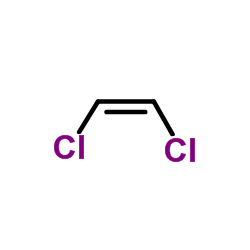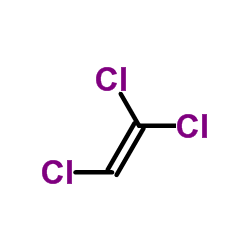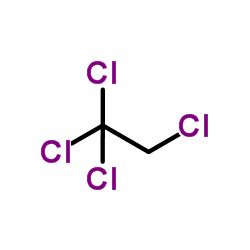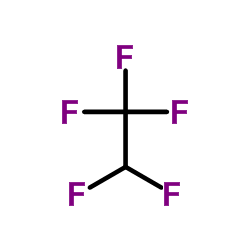(E)-1,2-Dichloroethene

(E)-1,2-Dichloroethene structure
|
Common Name | (E)-1,2-Dichloroethene | ||
|---|---|---|---|---|
| CAS Number | 156-60-5 | Molecular Weight | 96.943 | |
| Density | 1.2±0.1 g/cm3 | Boiling Point | 47.7±0.0 °C at 760 mmHg | |
| Molecular Formula | C2H2Cl2 | Melting Point | -57ºC(lit.) | |
| MSDS | Chinese USA | Flash Point | 6.1±0.0 °C | |
| Symbol |


GHS02, GHS07 |
Signal Word | Danger | |
| Purity | Quantity | Budget | Inquiry |
|---|
| Name | trans-1,2-dichloroethene |
|---|---|
| Synonym | More Synonyms |
| Density | 1.2±0.1 g/cm3 |
|---|---|
| Boiling Point | 47.7±0.0 °C at 760 mmHg |
| Melting Point | -57ºC(lit.) |
| Molecular Formula | C2H2Cl2 |
| Molecular Weight | 96.943 |
| Flash Point | 6.1±0.0 °C |
| Exact Mass | 95.953354 |
| LogP | 1.75 |
| Vapour Pressure | 333.1±0.0 mmHg at 25°C |
| Index of Refraction | 1.453 |
| Stability | Incompatible with oxidizing agents, bases. Stable, but may decompose on exposure to air, moisture or light. Highly flammable. |
CHEMICAL IDENTIFICATION
HEALTH HAZARD DATAACUTE TOXICITY DATA
MUTATION DATA
|
| Symbol |


GHS02, GHS07 |
|---|---|
| Signal Word | Danger |
| Hazard Statements | H225-H332-H412 |
| Precautionary Statements | P210-P273 |
| Personal Protective Equipment | Eyeshields;Faceshields;full-face respirator (US);Gloves;multi-purpose combination respirator cartridge (US) |
| Hazard Codes | Xn: Harmful;F: Flammable;T: Toxic; |
| Risk Phrases | R11;R20;R52/53 |
| Safety Phrases | 7-16-29-61-45-36/37 |
| RIDADR | UN 1150 3/PG 2 |
| WGK Germany | 2 |
| RTECS | KV9400000 |
| Packaging Group | II |
| Hazard Class | 3 |
| HS Code | 2903299090 |
~% |
| Literature: Journal of the American Chemical Society, , vol. 56, p. 1322 |
~% |
| Literature: DE747814 , ; DRP/DRBP Org.Chem. |
~99% |
| Literature: The Dow Chemical Company Patent: US4384159 A1, 1983 ; |
| HS Code | 2903299090 |
|---|---|
| Summary | 2903299090 other unsaturated chlorinated derivatives of acyclic hydrocarbons。Supervision conditions:None。VAT:17.0%。Tax rebate rate:9.0%。MFN tariff:5.5%。General tariff:30.0% |
|
Calculating virtual log P in the alkane/water system (log P(N)(alk)) and its derived parameters deltalog P(N)(oct-alk) and log D(pH)(alk).
J. Med. Chem. 48 , 3269-79, (2005) Growing interest in the use of both the logarithm of the partition coefficient of the neutral species in the alkane/water system (log P(N)(alk)) and the difference between log P(N)(oct) (the logarithm... |
|
|
QSPR modeling of octanol/water partition coefficient for vitamins by optimal descriptors calculated with SMILES.
Eur. J. Med. Chem. 43 , 714-40, (2008) Simplified molecular input line entry system (SMILES) has been utilized in constructing quantitative structure-property relationships (QSPR) for octanol/water partition coefficient of vitamins and org... |
|
|
Demonstration of compound-specific isotope analysis of hydrogen isotope ratios in chlorinated ethenes.
Environ. Sci. Technol. 47(3) , 1461-7, (2013) High-temperature pyrolysis conversion of organic analytes to H(2) in hydrogen isotope ratio compound-specific isotope analysis (CSIA) is unsuitable for chlorinated compounds such as trichloroethene (T... |
| Acetylene dichloride, trans- |
| E-1,2-dichloroethene |
| trans-1, 2-Dichloroethene |
| trans-1,2-Dichloroethylene,stabilized |
| 1,2-Dichloroethene, trans- |
| (E)-1,2-dichloroethylene |
| Ethylene, 1,2-dichloro-, (E)- |
| trans-dichloroethylene |
| Dichloroethylene, trans- |
| Ethene, 1,2-dichloro-, (1E)- |
| 1,2-Dichloroethylene (trans) |
| Ethene, 1,2-dichloro-, (E)- (9CI) |
| TRANS-ACETYLENE DICHLORIDE |
| 1,2-trans-dichloroethene |
| trans-1,2-DCE |
| Ethene, 1,2-dichloro-, (E)- |
| Ethylene, 1,2-dichloro-, trans- |
| 1,2-trans-dichloroethylene |
| TRANS-1,2-DICHLOROETHENE |
| acetylene dichloride |
| trans-1,2-Dichloroethylene |
| ethene, (E)-1,2-dichloro- |
| EINECS 205-860-2 |
| 1,2-dichloroethylene |
| MFCD00062942 |



 CAS#:74-86-2
CAS#:74-86-2 CAS#:79-01-6
CAS#:79-01-6 CAS#:630-20-6
CAS#:630-20-6 CAS#:127-18-4
CAS#:127-18-4 CAS#:7553-56-2
CAS#:7553-56-2 CAS#:107-06-2
CAS#:107-06-2![2-phenylspiro[cyclopropane-1,9'-fluorene] structure](https://image.chemsrc.com/caspic/005/10423-18-4.png) CAS#:10423-18-4
CAS#:10423-18-4 CAS#:87319-65-1
CAS#:87319-65-1![(2S,3R)-2,3-dichlorospiro[cyclopropane-1,9'-fluorene] structure](https://image.chemsrc.com/caspic/162/87319-63-9.png) CAS#:87319-63-9
CAS#:87319-63-9 CAS#:87319-64-0
CAS#:87319-64-0 CAS#:431-06-1
CAS#:431-06-1 CAS#:430-88-6
CAS#:430-88-6 CAS#:431-07-2
CAS#:431-07-2 CAS#:354-33-6
CAS#:354-33-6 CAS#:76-15-3
CAS#:76-15-3